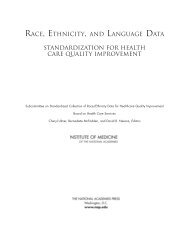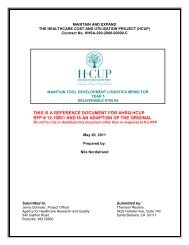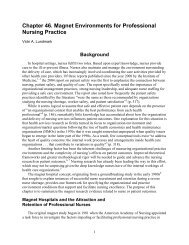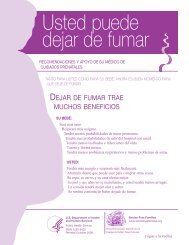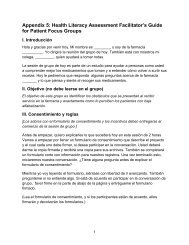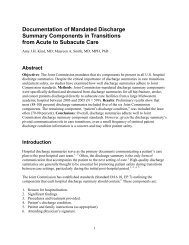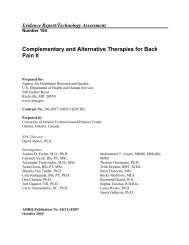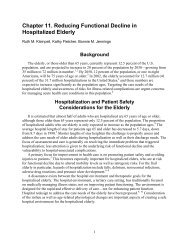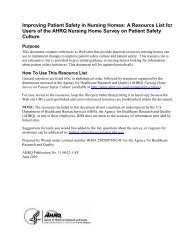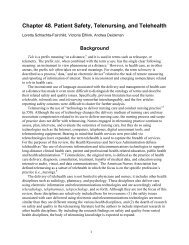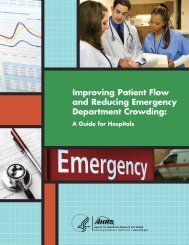Stories of Success: Using CUSP To Improve Safety - Agency for ...
Stories of Success: Using CUSP To Improve Safety - Agency for ...
Stories of Success: Using CUSP To Improve Safety - Agency for ...
Create successful ePaper yourself
Turn your PDF publications into a flip-book with our unique Google optimized e-Paper software.
Services, one <strong>of</strong> whose members asked, “When you don’t post the right contact precautions<br />
outside the door, we are not going to clean the right way.” Bartley continued, “It was eye<br />
opening <strong>for</strong> some <strong>of</strong> us. She was very nervous as she talked, but then she found that, ‘they are<br />
listening to me.’ That’s a powerful experience.” One <strong>of</strong> the solutions was to make sure that staff<br />
put the right isolation precaution sign and the correct protective gear on the yellow caddy outside<br />
the rooms <strong>of</strong> patients who are in isolation.<br />
Multidisciplinary rounds are held every morning. Bartley coordinates rounding, oversees practice<br />
and communicates with those who cannot attend. “I feel like a spider in the middle <strong>of</strong> a web. I<br />
collaborate with the charge nurse about incoming patients in order to plan <strong>for</strong> staffing, update the<br />
nutritionist on patients needing tube feedings, alert the case manager about patients who are<br />
moving to a different unit or outside the hospital to plan <strong>for</strong> discharge papers, keep the social<br />
worker updated on patient and family issues, collaborate with the respiratory therapist on<br />
ventilator and therapy changes that were discussed during rounds.”<br />
Debriefings or specialized huddles are held when a pressure ulcer develops or someone has a<br />
fall: How did it happen? What can be done to prevent it from happening again? Goals <strong>of</strong> the day<br />
<strong>for</strong> each patient are written on a white board that also shows when a central line was started.<br />
During shift hand<strong>of</strong>fs, nurses overlap briefly to have direct conversations about the patient at the<br />
bedside. Interns and residents go through orientation be<strong>for</strong>e they come to the ICU. They<br />
participate in simulation training facilitated by the ICU Medical (MICU). Bartley orients and<br />
educates staff about MICU practices, evidence-based practices, bundles and proper use <strong>of</strong><br />
equipment.<br />
<strong>CUSP</strong> work was understood as such by some at Saint Joe’s, but this work was largely carried out<br />
under the umbrella <strong>of</strong> safety and Keystone, sort <strong>of</strong> “mushed together,” in Posa’s words. “‘Culture<br />
<strong>of</strong> safety’ pulls on all the components <strong>of</strong> <strong>CUSP</strong>.”<br />
Bartley concurred, “When I think <strong>of</strong> <strong>CUSP</strong>, it’s all the things we do to make the patient safe:<br />
eliminating BSI, CAUTI, UTI, VAP—it’s comprehensive, like its name. It’s about learning from<br />
defects. It’s a way <strong>of</strong> thinking that leads to more exploration <strong>of</strong> other things.”<br />
Expanding Scope<br />
Posa and other members <strong>of</strong> the Keystone Team immerse themselves in emerging evidence in<br />
caring <strong>for</strong> critically ill patients. They bring research and ideas to the group and ask if members<br />
want to pursue them. Posa is also deeply involved in a two-way flow <strong>of</strong> evidence-based practice<br />
at Saint Joe’s parent organization, Trinity Health and her counterparts in sister hospitals.<br />
When the Michigan grant and work with Johns Hopkins ended, Keystone <strong>for</strong>med an advisory<br />
board <strong>of</strong> ICU nurses and physicians from across the state. Posa said, “We and other hospitals<br />
implement evidence based practices <strong>for</strong> treating sepsis, preventing delirium and progressive<br />
mobility, and then push it up to Keystone, after which it is implemented statewide.”<br />
Sepsis<br />
Through these various conversations, in 2004, the Keystone Team had begun discussing the new<br />
Surviving Sepsis Campaign’s guidelines <strong>for</strong> bringing down the very high mortality rates from<br />
sepsis, and led the introduction <strong>of</strong> the sepsis bundle into the ICUs and ED in 2006. Any patient<br />
26



